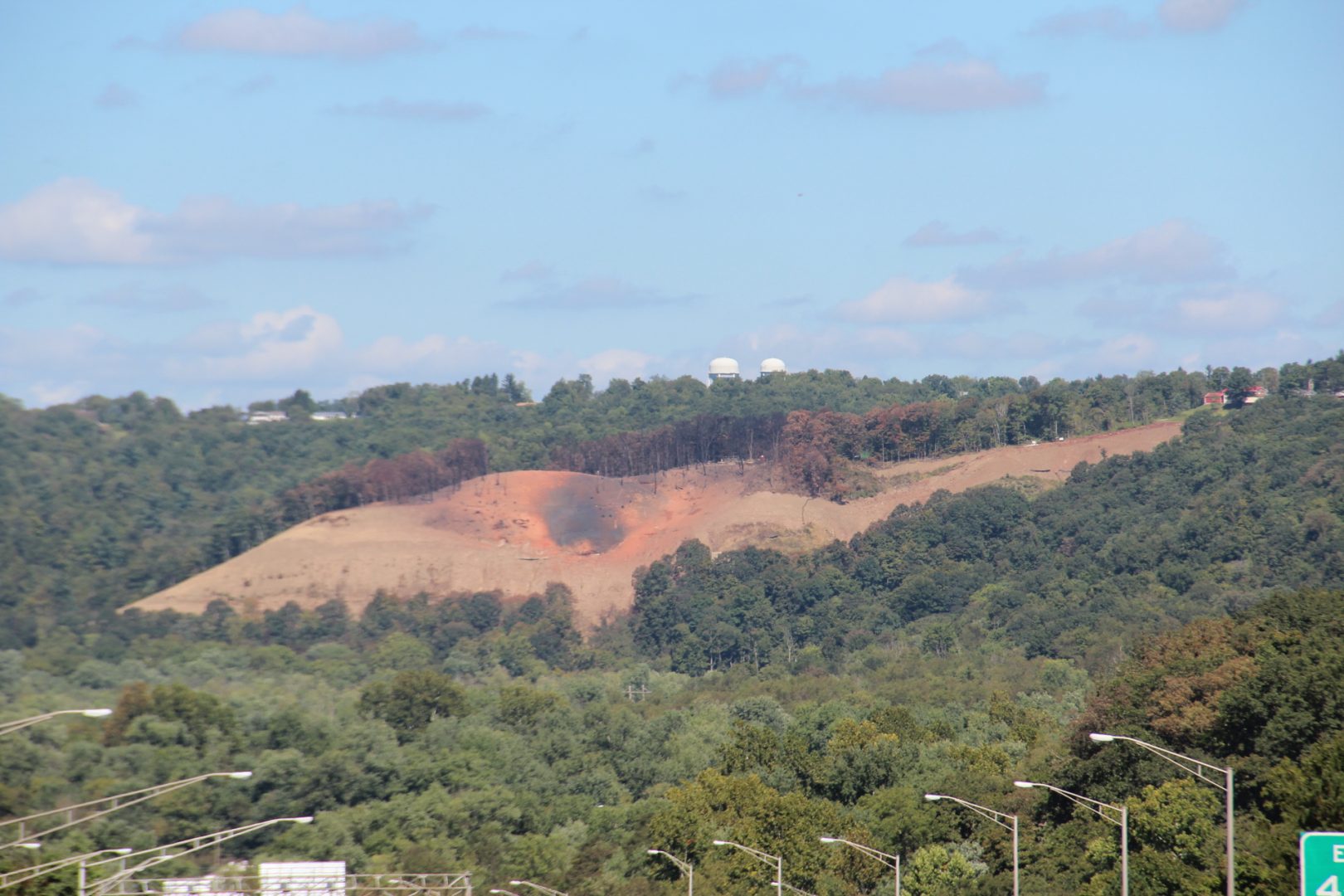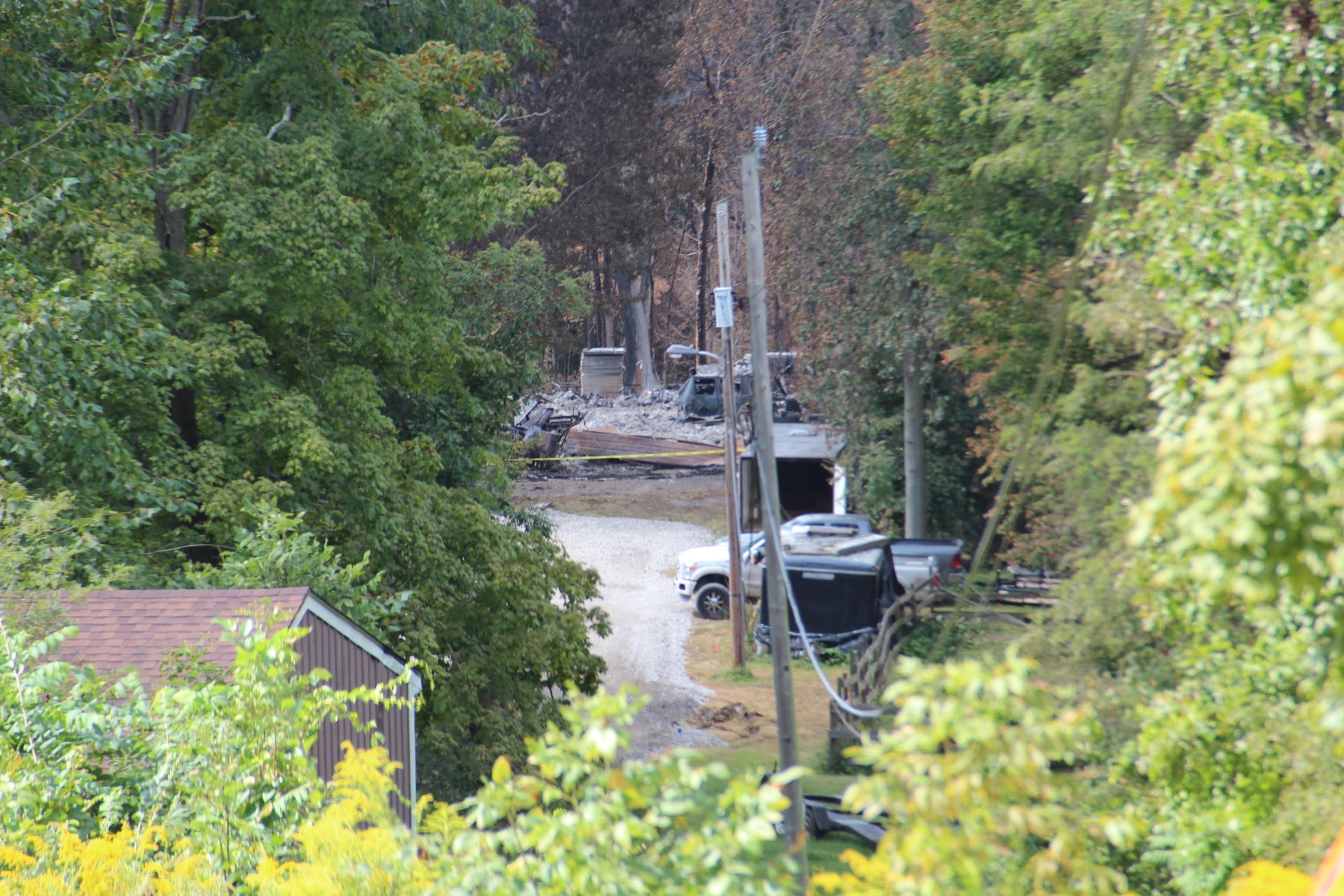
The site of an explosion of the Energy Transfer Partners Revolution Pipeline, Center Township, Beaver County.
Reid R. Frazier/StateImpact Pennsylvania


The site of an explosion of the Energy Transfer Partners Revolution Pipeline, Center Township, Beaver County.
Reid R. Frazier/StateImpact Pennsylvania

Reid R. Frazier/StateImpact Pennsylvania
The site of an explosion of the Energy Transfer Partners Revolution Pipeline, Center Township, Beaver County.
When the Revolution pipeline blew up down the street from his house, Chuck Belczyk thought a bomb had gone off.
“It was something that you don’t ever want to hear,” Belczyk said. “It shook the whole neighborhood.”
Belczyk was asleep in his house when the explosion happened, shortly before 5 a.m. Sept. 10.
Officials believe a landslide caused by heavy rains led to the explosion of the 24-inch pipeline, owned by Energy Transfer Partners. The pipeline had been in operation for only a week. The fire destroyed a neighbor’s home, but no one was hurt.
During the months the pipeline was under construction, Belczyk wasn’t happy that it was so close to his house, about 100 yards from his back door on Ivy Lane in Center Township, Beaver County.
But there was little he could do about it.
“What are you going to do?” he said. “This is where you live. If we owned the property it might have been a different story, (but) we had no say-so.”

Reid R. Frazier/StateImpact Pennsylvania
Chuck Belczyk, of Center Township, Beaver County, lives 100 yards from the Revolution Pipeline, owned by Energy Transfer Partners.
It turns out no one — no federal, state, or local government — has much of a say-so in where pipelines like this one can go. That’s because of a hole in the patchwork of federal and state regulations that oversee pipeline construction.
A pipeline route that crosses state lines has to get federal approval from the Federal Energy Regulatory Commission, or FERC.
But the Revolution doesn’t cross state lines — it only carries gas from Butler County to Washington County. For Pennsylvania-only pipelines, siting regulations only come into play when the route crosses a stream or wetland.
In February, a Commonwealth Court panel of judges ruled municipalities can’t control siting of pipelines through zoning. The judges said that authority ultimately rests with the Pennsylvania Public Utility Commission, the state’s main regulator for pipelines. But the PUC says state law doesn’t allow it to oversee siting, and it would need action by the legislature to do so.
Andrew Place, the vice chairman of the commission, thinks the PUC — or some state agency — should have siting power for pipelines, just like the PUC does with overhead powerlines.
He says that would give more say to local communities along pipeline routes.
“If I’m a township and I’ve got a 20-year plan of where my roads are likely to go or where shopping districts might go or where housing might go, I have an interest in the sort of infrastructure pieces coming through my township,” Place said.
He said some type of siting approval would allow the state to take a more global look at pipeline routes so that it can minimize their impacts.
“You can look at the broader questions,” Place said. “(We can ask) what’s the most protective of the environment and human health path you can take, and select that.”
Under FERC approval, companies are required to provide alternative routes to the one they have proposed, and affected landowners and communities can comment on a proposed route. On occasion, FERC changes routes or operational details of pipelines, but the agency rarely rejects pipeline projects.

Reid R. Frazier / StateImpact Pennsylvania
The remnants of a home and garage destroyed by the explosion of the Revolution Pipeline.
A bill introduced by state Sen. Andrew Dinniman, a Democrat from suburban Philadelphia, would give the PUC similar authority. Dinniman said his concern grew out of constituent complaints that the Mariner East 2 pipeline goes too close to schools, libraries, and houses in his district.
Like the Revolution, the Mariner East 2 is an intra-state pipeline, carrying natural gas liquids from Western Pennsylvania to a refinery near Philadelphia. Mariner East 2 is expected to be operational this month, joining Mariner East 1.
“Because the state has no siting authority, the PUC essentially lets the pipeline be built wherever the company wants it to be built,” Dinniman said.
Dinniman said oversight from the PUC would allow the public to comment on projected pipeline routes, and push the commission to implement stricter safety measures in densely populated areas.
“Hopefully, by granting some siting authority, it will force the PUC to ask the questions they should be asking anyway,” Dinniman said.
But it’s unclear how far this idea will go. Dinniman’s bill remains stuck in committee, and the oil and gas industry is opposed to it.
Dave Spigelmyer, president of the Marcellus Shale Coalition, an industry trade group, called the bill an effort to stop or slow down pipeline development.
He says pipeline companies try to keep their routes away from sensitive areas. Spigelmyer says natural gas brings economic benefits, and has helped displace the dirtier power source of coal.
“The benefits are extraordinary and we can’t find ways to slow its development. We should be encouraging its development,” Spigelmyer said.
Back in Beaver County, Chuck Belczyk says even if there were more oversight of where pipelines can be built, he’s not sure it would do much to keep them away from his neighborhood.
“How far do you push that? Are you going to win the battle in the long run? All’s it’s going to do is cost you time and money. That’s the bottom line. How do you fight that?”
StateImpact Pennsylvania is a collaboration among WITF, WHYY, and the Allegheny Front. Reporters Reid Frazier, Rachel McDevitt and Susan Phillips cover the commonwealth’s energy economy. Read their reports on this site, and hear them on public radio stations across Pennsylvania.
(listed by story count)
StateImpact Pennsylvania is a collaboration among WITF, WHYY, and the Allegheny Front. Reporters Reid Frazier, Rachel McDevitt and Susan Phillips cover the commonwealth’s energy economy. Read their reports on this site, and hear them on public radio stations across Pennsylvania.
Climate Solutions, a collaboration of news organizations, educational institutions and a theater company, uses engagement, education and storytelling to help central Pennsylvanians toward climate change literacy, resilience and adaptation. Our work will amplify how people are finding solutions to the challenges presented by a warming world.